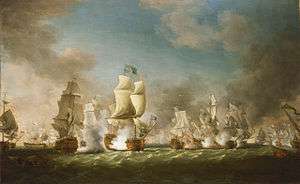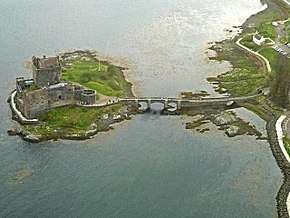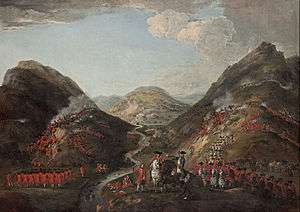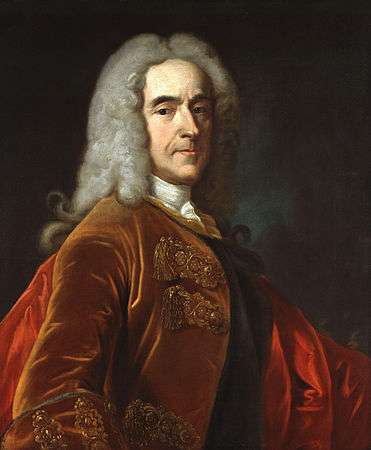Jacobite rising of 1719
| The Jacobite Rising of 1719 | |||||||
|---|---|---|---|---|---|---|---|
| Part of Jacobite risings | |||||||
 George Keith, 10th Earl Marischal; led the 1719 expedition to Scotland | |||||||
| |||||||
| Belligerents | |||||||
|
Jacobites |
| ||||||
| Commanders and leaders | |||||||
|
George Keith, 10th Earl Marischal Marquess of Tullibardine Earl of Seaforth | General Joseph Wightman | ||||||
The Jacobite rising of 1719 or the Nineteen was a Spanish-backed landing in Scotland, originally planned as part of a larger rising in South-West England to restore James Francis Edward Stuart to the throne of Great Britain. Only the Scottish element took place and while there were a number of minor actions, defeat at the Battle of Glen Shiel in June effectively ended the Rising.[1]
Background

The 1713 Treaty of Utrecht forced Spain to cede the islands of Sicily and Sardinia to Austria and Savoy and their recovery was a priority for Giulio Alberoni, the new Chief Minister. Neither Austria or Savoy possessed significant maritime forces and instead relied on the Royal Navy; regaining Spanish Italy required the British to withhold this support or be prevented from doing so.
France, traditional choice of those seeking help against Britain, needed peace and in 1716 the Anglo-French Treaty ended official support for the exiled Stuarts.[2] This meant George I's succession passed relatively smoothly despite the 1715 Jacobite Rising which had significant support in both England and Scotland.

In 1717, Alberoni sent an amphibious force to re-occupy Sardinia; he was allowed to do so unopposed but when the Spanish landed on Sicily in 1718, Britain, France, the Netherlands and Austria formed the Quadruple Alliance to enforce Utrecht.[lower-alpha 1] On 11 August the Royal Navy destroyed a Spanish fleet at the Battle of Cape Passaro although the War of the Quadruple Alliance did not start until December.[lower-alpha 2]
Alberoni viewed a Jacobite invasion as a way of diverting British resources from the Mediterranean; his plan called for 7,000 Spanish troops under the Duke of Ormonde to land in South-West England, march on London and restore James Stuart. Ormonde had become friendly with Charles XII of Sweden due to his involvement in mediation to end the Great Northern War between Sweden and Russia.[3] He and Charles added a rising in Scotland led by George Keith to capture Inverness, allowing a Swedish naval expeditionary force to disembark.[lower-alpha 3][4]

Ormonde waited in Corunna while the invasion fleet assembled in Cadiz and was joined there by James.[5] Departure was scheduled for early February but delays allowed the British to position naval units [lower-alpha 4] and reinforce proposed landing spots using French-supplied intelligence.[6] Ormonde wrote a series of increasingly pessimistic letters to Alberoni telling him the plan was no longer viable.[7] The fleet finally left Cadiz for Corunna in late March carrying 5,000 soldiers but was severely damaged by a two day storm off Cape Finisterre on 29 March and the invasion cancelled.
Historians like Harcourt-Smith question how serious Alberoni was about the invasion.[8] Unlike other statesmen of the period, he had direct experience of amphibious operations while Cape Passaro demonstrated the Royal Navy's power in far less favourable circumstances. He would have been well aware the Spanish fleet was unlikely to even reach England, let alone be allowed to disembark large numbers of troops. A potential invasion was more useful in occupying the Royal Navy and far less risky; this would explain why he did not share Ormonde's concern at the delays and made the fleet just as useful moored in Corunna, its destination when it left Cadiz.
Charles XII's death in November 1718 ended Swedish participation and the purpose of the Scottish landings but Keith and 300 Spanish soldiers left Pasajes on 8 March aboard two frigates. They reached Stornoway in the Isle of Lewis where they were joined by a group of exiles from France, including the Earl of Seaforth, chief of Clan Mackenzie (Scottish Gaelic: Uilleam Dubh Shìophort), James Keith, the Marquess of Tullibardine, Lord George Murray and Cameron of Lochiel.[lower-alpha 5][9]
Tullibardine wanted to hear from Ormonde, while George Keith urged moving quickly to capture Inverness before the garrison was warned. His view prevailed and on 13 April, they landed at Lochalsh in Mackenzie territory and set up base in Eilean Donan where they learned of Ormonde's failure. Tullibardine produced a commission that made him leader of Jacobite land forces [lower-alpha 6] and recommended retreat but Keith prevented this by ordering the frigates back to Spain.[10]
The Jacobite force totalled about 1,000 including 400 Mackenzies, 150 Camerons, the Spanish troops and other small groups, including one led by Rob Roy MacGregor. Since they had more arms and ammunition than men, the excess was stored at Eilean Donan guarded by 40 Spanish soldiers while the rest prepared to march on Inverness.[11]
Capture of Eilean Donan Castle

After receiving news of the landing in Stornoway, five ships of the Royal Navy arrived in the area at the beginning of May. Since they were unaware the Spanish frigates had already left as instructed by Keith, this was a substantial force which included the 50-gun fourth-rates HMS Assistance, Worcester, Dartmouth and Enterprise plus a 24-gun sloop Flamborough.
While Assistance and Dartmouth patrolled the waters around Skye, Worcester, Enterprise and Flamborough anchored off Eilean Donan on the north side of Loch Duich early in the morning of Sunday 10 May.[lower-alpha 7] In the evening, a landing party captured the castle under cover of an intense cannonade and the prisoners taken by Flamborough to Edinburgh.[12] Captain Boyle of Worcester recorded them as 'an Irish captain, a Spanish lieutenant, a Spanish sergeant, thirty-nine Spanish soldiers and a Scots rebel.'[13]
Seeing this, the main Jacobite force marched inland; their options were limited since they could not escape by sea while a government force under Joseph Wightman was advancing towards them from Inverness. After blowing up the castle, the ships remained in Loch Duich for the next two weeks, searching for rebels while raiding the nearby town of Stromeferry and the island of Raasay.[14]
Battle of Glen Shiel

General Joseph Wightman left Inverness on 5 June for Glen Shiel with around 1,000 men and four Coehorn mortars. They reached Loch Cluanie on 9 June, less than 8 miles (13 km) from the Jacobite camp.
Tullibardine had prepared a strong position near the Five Sisters hills, with the Spanish in the centre and the Highlanders on the flanks behind a series of trenches and barricades. Wightman's force arrived about 4:00 pm on 10 June and began the attack an hour later by firing their mortars at the Jacobite flanking positions. This caused few casualties but the Scots had not encountered mortars before, allowing Wightman's infantry to advance up the hill to their lines, then use grenades to bomb them out of their positions. The Spanish stood their ground but had to withdraw up the mountain as their flanks gave way.[15]

The battle lasted until 9:00 pm; several accounts claim the heather caught fire and smoke combined with failing light enabled the bulk of the Scots to disappear into the night. The Spanish surrendered next morning and as regular troops were shipped home; Lord George Murray, Seaforth and Tullibardine were wounded but the Jacobite leaders also managed to escape. An analysis by historian Peter Simpson attributes Wightman's victory to skilful use of mortars, the superior firepower of his grenadiers and the aggression shown by his infantry, especially the Munro Independent Company.[16] A brief description of the battle and the background appears in Scottish author Tobias Smollett's History of England.
Lord Carpenter, commander in Scotland, advised London pursuing the rebels was impractical and it was best to let them go, as the Rising had simply damaged the Jacobite cause.[17] Tullibardine concurred; in his letter of 16 June 1719 to the Earl of Mar he provides a description of the battle and states 'it bid fair to ruin the King's Interest and faithful subjects in these parts.'[18]
Aftermath
In October 1719, a British naval expedition under Lord Cobham landed 6,000 troops in the Spanish port of Vigo; they held it for ten days, destroyed vast quantities of stores and equipment, then re-embarked unopposed. The nearby city of Santiago de Compostela even paid £40,000 in return for being left alone.[19] Arguably the most significant military action of the 1719 Rising, this was intended to show Britain could land large numbers of troops anywhere along the Spanish coastline and leave when they wanted.[20] Alberoni was dismissed and Spain renounced its Italian territories by the 1720 Treaty of the Hague, although they recovered Naples and Sicily during the War of the Polish Succession in 1734.

Carpenter's recommendation the rebels be allowed to return home proved sound advice. Seaforth's tenants continued paying rents to him even in exile and agents from the Commission of Forfeited Estates were unable to collect them as a result.[21] In 1721, the Mackenzies twice defeated government attempts to enforce payment at the battles of Glen Affric[22][23] and Coille Bhan.[24][23] This showed the Highlands could not be governed without the co-operation of the clan chiefs or heritors; it was only when Seaforth returned from exile in 1726 that the government restored control in the Mackenzie territories.[25]
Sales of property forfeited by Jacobites were either delayed by legal arguments or their proceeds reduced for often fictitious debts, making it easier to simply pardon them.[26] This eventually included even senior exiles such as Bolingbroke; others took service elsewhere like George and James Keith who both became Prussian generals. This was the background to the post-1745 abolition of the heritor system and the bitterness towards those like Lord George Murray pardoned for their roles in 1715 and 1719.
However, new laws actively discriminated against Non-Juring clergy ie those who refused to swear allegiance to the Hanoverian regime.[27] In 1690, more than half of the clergy were Non-Jurors and in theory deprived of their livings but many remained in place protected by the local gentry. One such example was Michael Fraser, who was appointed minister at Daviot and Dunlichty in 1673; [28] he was still there when he died in 1726, despite being evicted in 1694 and joining the 1715 and 1719 Risings.[29]
Previous attempts to reintegrate ministers like Michael Fraser by measures such as the 1712 Toleration Act had been resisted by the kirk's General Assembly.[30] After 1719, toleration changed to persecution and many now conformed as a result; Non-Juring Episcopalianism became a mark of Jacobite commitment and often associated with powerful local leaders, since their congregations required political protection. A high percentage of both Lowlanders and Highlanders who participated in the 1745 Rebellion came from this element of Scottish society.[31]
Footnotes
- ↑ Sicily was viewed by British commercial interests as a vital link in trading routes with the Levant, unlike Sardinia.
- ↑ The Dutch did not enter the war until June 1719; their shattered economy needed peace and trade with Spain.
- ↑ Sweden was engaged on the opposite side to George I who wanted Swedish territories in Germany for Hanover, an example of the complexity added to European politics by the ruler of Hanover also being King of Great Britain.
- ↑ Ormonde reported this included several British frigates on station off Cadiz watching the preparations.
- ↑ The British government complained to the French Regent, the Duke of Orléans about allowing them to do this; historian Bruce Lenman speculates this may have been seen by Orléans as a way of reducing the expensive grants made by Louis XIV to Jacobite exiles.
- ↑ Dickson's 1895 account states that this was a commission granted by the Irish Jacobite Count Dillon in 1717, relating to a previous planned invasion.
- ↑ The garrison later claimed the ships were flying Spanish colours, a standard naval ruse of the time.
References
- ↑ Lynch, Michael. (2011). Oxford Companion to Scottish History. p. 349. Oxford University Press. ISBN 978-0-19-923482-0.
- ↑ Szechi, Daniel (1994). The Jacobites: Britain and Europe, 1688-1788 (First ed.). Manchester University Press. pp. 93–95. ISBN 0719037743.
- ↑ Wills, Rebecca (2001). The Jacobites and Russia, 1715-1750. Tuckwell Press Ltd. p. 57. ISBN 1862321426.
- ↑ Klinger, PF. "The Jacobite Rebellion of 1719; Revenge & Regrets;" (PDF). The Scholarship.ecu.edu. Summary of Ormonde's Plan on P53. Retrieved 16 February 2018.
- ↑ Lenman, Bruce (1980). The Jacobite Risings in Britain 1689-1746. Eyre Methuen. p. 190. ISBN 0413396509.
- ↑ Lenman, Bruce (1980). The Jacobite Risings in Britain 1689-1746. Eyre Methuen. p. 191. ISBN 0413396509.
- ↑ Dickson, William Kirk. "The Jacobite Attempt of 1719; Letters of the Duke of Ormonde to Cardinal Alberoni". Archive.org. Retrieved 16 February 2018.
- ↑ Harcourt-Smith, Simon (1944). Cardinal of Spain: The Life and Strange Career of Alberoni. Knopf. p. 3 passim.
- ↑ Lenman, Bruce (1980). The Jacobite Risings in Britain 1689-1746. Eyre Methuen. p. 192. ISBN 0413396509.
- ↑ Lenman, Bruce (1980). The Jacobite Risings in Britain 1689-1746. Eyre Methuen. p. 192. ISBN 0413396509.
- ↑ Lenman, Bruce (1980). The Jacobite Risings in Britain 1689-1746. Eyre Methuen. p. 193. ISBN 0413396509.
- ↑ Excerpts from the official logs of HMS Worcester and HMS Flamborough - /log_01.htm Lt Randolph Barker, HMS Flamborough clan-macrae.org.uk. Retrieved January 14, 2017.
- ↑ Smout CT (ed), Aldridge, David (1992). Scotland and the Sea; Jacobitism and Scottish Seas 1689-1791. John Donald Publishers Ltd. p. 89. ISBN 0859763382. Retrieved 17 February 2018.
- ↑ Smout CT (ed), Aldridge, David (1992). Scotland and the Sea; Jacobitism and Scottish Seas 1689-1791. John Donald Publishers Ltd. pp. 88–89. ISBN 0859763382. Retrieved 17 February 2018.
- ↑ Maggs, Stephen. "The Jacobite Rising and the Battle of Glen Shiel, 10 June, 1719" (PDF). G9. Retrieved 18 February 2018.
- ↑ Simpson, Peter (1996). The Independent Highland Companies; 1603-1760. John Donald. p. 103. ISBN 085976432X.
- ↑ Lenman, Bruce (1980). The Jacobite Risings in Britain 1689-1746. Eyre Methuen. p. 195. ISBN 0413396509.
- ↑ Dickson, William Kirk. "The Jacobite Attempt of 1719; Letters of the Duke of Ormonde to Cardinal Alberoni". Retrieved 18 February 2018.
- ↑ Rodger, NAM (2006). The Command of the Ocean: A Naval History of Britain 1649-1815; Volume 2. Penguin. p. 229. ISBN 9780141026909.
- ↑ Simms, Brendan (2008). Three Victories and a Defeat: The Rise and Fall of the First British Empire, 1714-1783. Penguin. p. 141. ISBN 9780140289848.
- ↑ Szechi, Daniel, Sankey, Margaret (November 2001). "Elite Culture and the Decline of Scottish Jacobitism 1716-1745". Past & Present. 173: 108 passim. JSTOR 3600841.
- ↑ Mackinnon, Donald. (1954). The Clan Ross. p. 24. W & A K Johnston's Clan Histories. Edinburgh and London.
- 1 2 Mackenzie, Alan. (2006). History of the Mackenzies. Chapter 10. pp. 142–144.
- ↑ Mackenzie, Alexander. (1894). History of the Mackenzies: With Genealogies of the Principal Families of the Name. pp. 310–311.
- ↑ Szechi, Daniel, Sankey, Margaret (November 2001). "Elite Culture and the Decline of Scottish Jacobitism 1716-1745". Past & Present. 173: 108. JSTOR 3600841.
- ↑ Szechi, Daniel, Sankey, Margaret (November 2001). "Elite Culture and the Decline of Scottish Jacobitism 1716-1745". Past & Present. 173: 110–111. JSTOR 3600841.
- ↑ Strong, Rowan (2002). Episcopalianism in Nineteenth-Century Scotland: Religious Responses to a Modernizing Society. OUP Oxford. p. 15. ISBN 0199249229.
- ↑ Macpherson, J. "The Parish of Daviot and Dunlichity". www.strathnairnheritage.org.uk. Retrieved 13 February 2018.
- ↑ Lenman, Bruce (1995). The Jacobite Risings in Britain, 1689-1746. Scottish Cultural Press. p. 56. ISBN 189821820X.
- ↑ Dickinson, HT (ed) (2006). Eighteenth Century Britain (Blackwell Companions to British History). John Wiley & Sons. p. 268. ISBN 1405149639.
- ↑ Szechi, Daniel, Sankey, Margaret (November 2001). "Elite Culture and the Decline of Scottish Jacobitism 1716-1745". Past & Present. 173: 97 passim. JSTOR 3600841.
Bibliography
- Abraham Alonso; Misión en Escocia (May 2005);
- Corp, Edward; The Jacobites at Urbino: An Exiled Court in Transition (AAIA 2009);
- Dickson, William K; The Jacobite Attempt of 1719 (Edinburgh University Press, 1895);
- Lenman, Bruce; The Jacobite Risings in Britain, 1689-1746 (Methuen Publishing, 1984);
- Mackie, J.D.; A History of Scotland (Penguin, 1982);
- Simpson, Peter; The Independent Highland Companies 1603-1760 (John MacDonald Publishing, 1996);
- Smout, CT (editor); Scotland and the Sea (John MacDonald Publishing, 1992);
- Spiers, Crang & Strickland; A Military History of Scotland (Edinburgh University Press, 2012);
- Wills, Rebecca; The Jacobites and Russia, 1715-1750 (Tuckwell Press, 2001).

.svg.png)